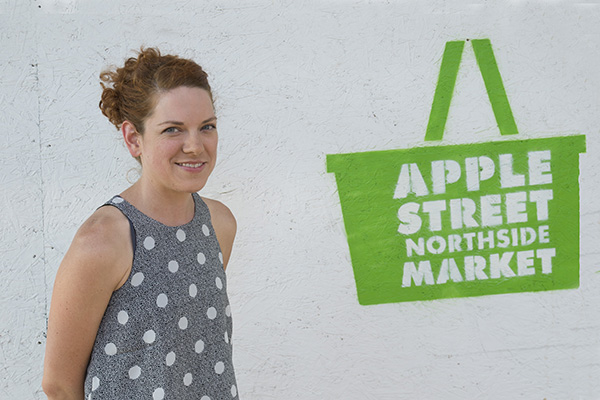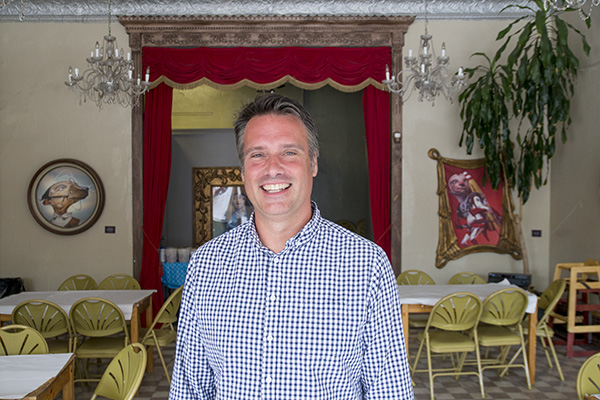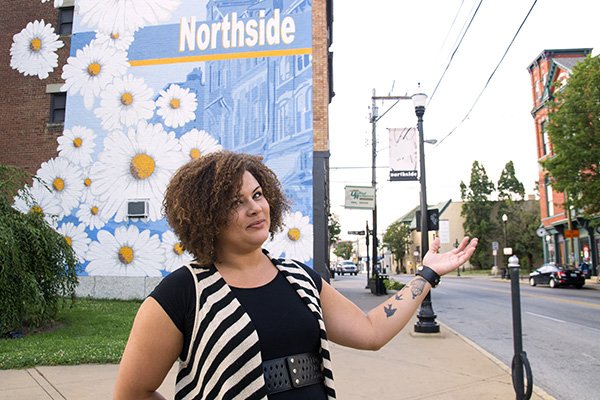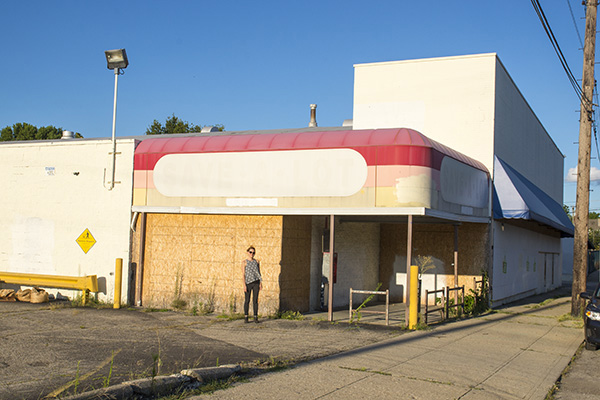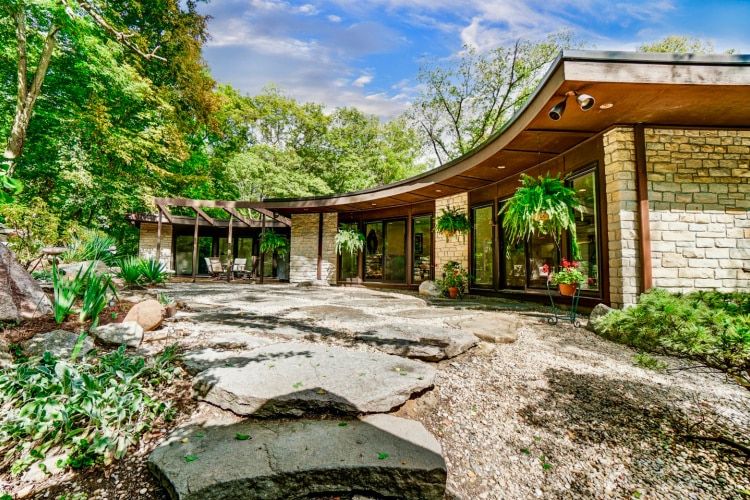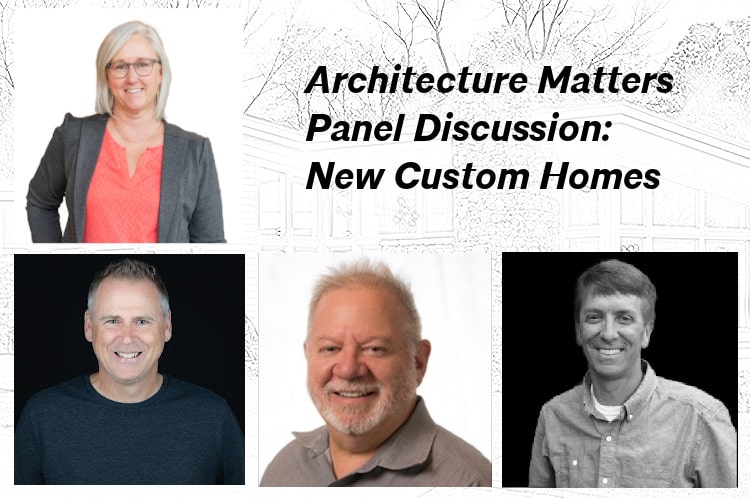Neighborhood Heroes: Building community in Northside
Maybe you know Northside for its 4th of July Parade, cool restaurants and bars or collection of shops selling all things vintage. But residents will tell you their community is much more thanks to neighborhood heroes who focus on inclusion.
In the family of Cincinnati neighborhoods, Northside is the quirky little sister who somehow makes Mom’s frumpy dress look cool and turns broken plastic toys into artwork. She prides herself on her eclectic collection of friends and is equally progressive and unpretentious.
Maybe you know Northside for its 4th of July Parade, cool restaurants and bars or its collection of shops selling all things vintage. But like most city neighborhoods, residents say there’s more to it than meets the eye. It’s a community built on inclusion, thanks to a large number of people working hard to keep Northside eclectic, progressive and unpretentious.
This is the fourth story in the Soapbox series “Neighborhood Heroes,” which celebrates everyday folks who do what they can do to make their corners of the world better and as a result become the heartbeat of their communities. Previous stories focused on Pleasant Ridge, Walnut Hills and Bellevue.
In this installment, we speak with three residents who help give Northside its unique and inclusive personality. They’re creating a community grocery store, offering opportunities for families to come together and keeping everyone involved and informed without exception.
Together, these residents aren’t just providing services. They’re creating true community.
Mary Jo Minerich
“I like Northside because it has a character, but it isn’t a character overly defined by any one thing,” says Mary Jo Minerich, who relocated from Oakland, Calif. in 2009 to study architecture. “Northside’s worst side is the best ‘worst side’ of any place I’ve ever seen.”
Northsiders work collaboratively to find solutions even when there’s disagreement, she says, something she experienced first-hand in May 2013.
“Gantry Project developers were talking about ‘revitalizing the neighborhood,’ and I felt like that was a horrible misconception to not understand the vitality that already existed,” Minerich says. “That language concerned me a lot.”
She utilized her architectural skills to help neighbors propose changes to the apartment and retail project at Hamilton Avenue and Blue Rock Road to better fit the community. This engagement led to small but impactful alterations to the project design and helped Minerich see that she could play a larger role Northside.
Later that year, Northside’s only grocery store, Save-A-Lot, closed and left many in the area without easy access to groceries. The closest grocery store is three miles away, but buses aren’t conveniently routed to get people there.
Minerich helped try to attract another store, creating numerous sketches showing the Save-A-Lot building’s potential.
“We identified the most obvious problems and said, ‘We can work around this,’ but the grocery chains have their own growth plans,” she says.
Meanwhile, Northside resident Heather Sturgill contacted Cincinnati Union Co-op Initiative (CUCI) and a new idea took shape. CUCI created a business plan for Apple Street Market, a community-owned store for residents by residents.
The goal was to sell 1,000 shares of the market at $100 each (with subsidized shares based on household income) to start construction and another 500 before it opened. Minerich helped create the owner’s kit and promotional materials.
“I never thought of myself as a marketing person, but you have to be adaptable when you get involved in a project like this,” she says.
The group has almost reached its initial goal with approximately 970 owners. Minerich and her colleagues at GBBN — where she works as an architectural interm — are creating permit drawings pro bono with hopes to start construction in September and open in spring/summer of 2016.
“I don’t cook,” Minerich says. “When my husband’s out, I eat marshmallows and hard-boiled eggs for dinner. It’s disgusting. But the idea of being able to get up on Saturday morning, walk to the store and find what I need and knowing all my neighbors can do the same is the best part of this. Understanding what this means to the people who need it the most is really motivating for all of us.”
Tommy Rueff
In 1998, Tommy Rueff had co-founded Barefoot Advertising and was creating artwork on the side when he received a call from the Contemporary Arts Center asking to bring a group of fourth graders to see his home studio. He jumped at the chance.
“It was awesome,” he says. “I took the day off work, got a friend to help and we made art together.”
As the students were leaving, Rueff’s friend said, “These kids are never going to forget today.”
Rueff travelled to Chicago the next morning and spent the drive reflecting on his own childhood memories.
“I kept going back to this swim coach who gave free lessons to parents and kids,” he says. “My dad enrolled us, and we both learned how to swim. I remembered those moments my dad and I spent together.”
Rueff wanted to create meaningful experiences for families just like that coach had. He came up with the concept for Happen Inc., a nonprofit that teaches art to parents and children.
“I went to my business partner and said, ‘Buy me out,’ and he totally got it,” Rueff says.
Although he originally opened Happen Inc. in Corryville, Rueff moved it to his home neighborhood of Northside 10 years ago.
“Northside is a big melting pot with all walks of life,” he says. “I was sold immediately. I just want to be part of a community that cares, and I really believe Northside cares in so many different ways. A theme to our work at Happen is that community is not just where you live, it’s how you live with other people.”
Rueff started by providing open studio time for neighbors to learn art but now runs eight different programs involving residents of Northside and beyond. Among them is the Make It Space where families learn about science, a youth group doing service and entrepreneurial projects, frequent special events and several community gardens — one provides produce for the Churches Active in Northside (CAIN) food pantry, while another allows children to “buy” produce by doing a good deed.
When Northside teens told Rueff they didn’t have enough food in summer, he started hosting free cookouts on Thursdays and Sundays.
Funding for these efforts comes in part from Happen’s Toy Lab. For $10, patrons choose pre-owned toy parts, fuse them together in new configurations and create one-of-a-kind toys. More than 13,000 toys have found new life so far, saving four tons of plastic from landfills.
“I have no (prior) experience in what I’m doing today,” Rueff says. “So I want people to think, ‘If Tommy can do it, I can do it.’ I really think that’s true. If you have a passion for something, go after it and help other people. I think we’ve created a spark, and we have a responsibility to keep it alive.”
Jeni Jenkins
Jeni Jenkins believes the secret to making an impact in your community is simple.
“Come to the table,” she says. “Listen. Hear what’s happening and then insert your skill where needed.”
Shortly after moving to Northside nine years ago, she began attending community council meetings to learn more about the neighborhood and was soon asked to join, participating in the education committee and in arts-related projects. At one meeting in 2013, the editor of a community newsletter requested help with the publication.
Jenkins had experience laying out a newspaper through her work producing Streetvibes with the Greater Cincinnati Homeless Coalition, so she offered to help. Within a month, the editor retired and the council looked to Jenkins to determine next steps.
She decided to create a new and improved paper from scratch, The Northsider. Then she and the council formed a nonprofit LLC to manage funding.
“So I created this beast of a paper,” Jenkins says, laughing. “I thought I’d set up the structure, help for a year and then pass it on to someone else.”
Nearly two years later, she’s still devoting 30-40 hours each month to the effort. What was once a basic newsletter is now a 26-page publication involving dozens of writers, editors and photographers.
Articles focus on Northside news and events but also topics as varied as health, social justice and film reviews. A cover contest each month allows local artists to submit their work for the front page.
The paper is rolled by Rueff and others at Happen Inc. and delivered by neighborhood kids to every doorstep in Northside, with a monthly circulation of 3,700-4,500.
“I like that it gets in the hands of people who wouldn’t traditionally come to community council meetings or who just moved to the neighborhood and don’t know what’s happening but want to be involved or who just can’t be involved because their lives are busy,” Jenkins says.
She also sees the paper as an economic development project because it illuminates Northside’s strengths.
“When I applied for the job I have now (as director of communications at Our Daily Bread), I brought the paper,” Jenkins says, recalling that the people interviewing her weren’t familiar with Northside. “After they read it they said, ‘Now I want to go there!’”
Jenkins was offered a small stipend to publish The Northsider, but she stopped taking it after eight issues so more money could go into production.
“I’m not trying to get rich,” she says. “I’m trying to help.”
Tell us about heroes in your neighborhood: Send suggestions for future “Neighborhood Heroes” stories to cincyheroes@gmail.com.

